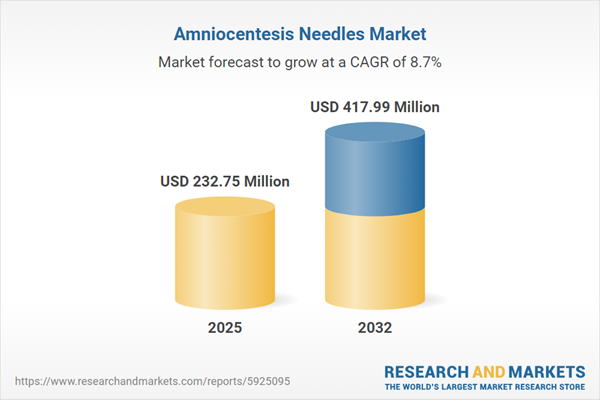Speak directly to the analyst to clarify any post sales queries you may have.
Strategic advancements in the amniocentesis needles market are fundamentally transforming procurement, clinical application, and regulatory compliance for healthcare providers worldwide. Senior decision-makers now operate at the intersection of evolving device technologies and adoption strategies, shaping operational excellence and improved patient outcomes.
Market Snapshot: Amniocentesis Needles Market Overview & Growth
The global amniocentesis needles market is projected to reach a value of USD 213.83 million in 2024, with forecasted growth to USD 232.75 million in 2025, and USD 417.99 million by 2032, representing a CAGR of 8.73%. The market’s momentum is driven by consistent enhancement in device engineering, integration with advanced clinical protocols, and a strengthened industry commitment to safety and procedural accuracy. Leading manufacturers focus substantial investments in innovation—advancing material science, optimizing ergonomic design, and enhancing clinician education. These initiatives target robust product differentiation, broader market adoption, and a steadfast reputation for reliability throughout healthcare environments.
Scope & Segmentation: Insights into the Amniocentesis Needles Market
- End Users: Ambulatory surgical centers, hospitals—public and private, diagnostic centers, and laboratories utilize amniocentesis needles, directly shaping device adaptability and procurement practices across health sectors.
- Applications: Clinical settings deploy high-precision needles for prenatal diagnostics such as fetal lung maturity testing, genetic analysis, infection identification, and risk assessment, supporting timely intervention strategies.
- Gauge Options: Available options include 20, 21, 22, and 23 gauge needles, with both echogenic and standard tip variants enhancing imaging clarity and procedural efficiency.
- Material Types: Medical-grade alloys and stainless steel compositions underpin compliance with global regulatory standards, prioritizing safety and consistent performance.
- Distribution Channels: Procurement is undertaken through direct government and private tenders, distribution agreements at multiple levels, manufacturer e-commerce, and verified third-party vendors, supporting tailored sourcing for diverse organizational procurement strategies.
- Geographical Coverage: North America, South America, Europe, Middle East and Africa, and Asia-Pacific each present unique reimbursement, regulatory, and supply chain factors influencing product access and uptake.
- Key Companies: Industry frontrunners include Becton, Dickinson and Company, Cook Medical LLC, B. Braun Melsungen AG, Teleflex Incorporated, Cardinal Health, Smiths Medical, Merit Medical Systems, Terumo Corporation, Nipro Corporation, and Medline Industries, each advancing clinician training, product development, and operational partnerships for continued competitiveness.
Key Takeaways: Strategic Guidance for Senior Decision-Makers
- Advances in engineering and broadening material options supply healthcare teams with dependable solutions responsive to evolving procedural requirements.
- Ergonomically improved and precisely designed needles contribute to streamlined workflows, enhancing practitioner efficiency and patient safety across varying care environments.
- Collaboration with suppliers introducing integrated imaging supports accelerated onboarding and strengthens adoption of new clinical technologies.
- Enhanced procurement flexibility supports organizational preparedness, facilitating rapid adaptation to shifting regulatory environments and regional market demands.
- Ongoing monitoring of regulations and continuous optimization of clinical protocols help sustain competitive positioning and ease access to advanced devices.
- Adjusting business approaches for diverse local requirements can bolster revenue continuity and open opportunities in emerging or complex markets.
Tariff Impact: Regulatory and Supply Chain Considerations
- Fluctuating U.S. tariffs on raw materials highlight the strategic benefit of robust domestic supply networks and partnerships with regional suppliers.
- Procuring materials locally stabilizes costs and inventory levels, though ongoing oversight and regular contract evaluation remain essential.
- Leveraging group purchasing and consolidated procurement strengthens contract terms and can stimulate innovation and supply chain resilience.
Methodology & Data Sources
This report draws on direct feedback from clinicians and procurement leaders, supported by regional survey results. A rigorous analytical framework, combined with expert input and current regulatory insights, builds a comprehensive perspective on trends in medical consumables and device markets.
Why This Report Matters for Senior Decision-Makers
- Actionable guidance on technological and market changes helps refine procurement and strategic risk management processes.
- Regional insights clarify compliance challenges and spotlight growth opportunities in diverse healthcare markets.
- Evidence-led analysis drives transparency and informed decision-making for executive leaders across supply chain and operational domains.
Conclusion
Adaptive procurement strategies, ongoing technological assessment, and strong regulatory vigilance are critical for sustained organizational resilience in the amniocentesis needles sector. Staying responsive ensures continued operational alignment as market standards evolve.
Additional Product Information:
- Purchase of this report includes 1 year online access with quarterly updates.
- This report can be updated on request. Please contact our Customer Experience team using the Ask a Question widget on our website.
Table of Contents
3. Executive Summary
4. Market Overview
7. Cumulative Impact of Artificial Intelligence 2025
Companies Mentioned
The companies profiled in this Amniocentesis Needles market report include:- Becton, Dickinson and Company
- Cook Medical LLC
- B. Braun Melsungen AG
- Teleflex Incorporated
- Cardinal Health, Inc.
- Smiths Medical, Inc.
- Merit Medical Systems, Inc.
- Terumo Corporation
- Nipro Corporation
- Medline Industries, L.P.
Table Information
| Report Attribute | Details |
|---|---|
| No. of Pages | 191 |
| Published | November 2025 |
| Forecast Period | 2025 - 2032 |
| Estimated Market Value ( USD | $ 232.75 Million |
| Forecasted Market Value ( USD | $ 417.99 Million |
| Compound Annual Growth Rate | 8.7% |
| Regions Covered | Global |
| No. of Companies Mentioned | 11 |









